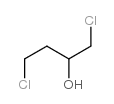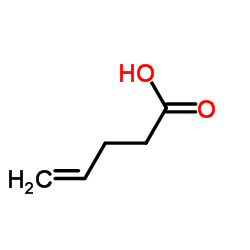2419-74-1
| 中文名 | 1,4-二氯-2-丁醇 |
|---|---|
| 英文名 | 1,4-dichloro-2-butanol |
| 中文别名 | 二氯丁醇 |
| 英文别名 |
1,4-dichloro-butan-2-ol
DI CHLORIDE NORMAL BUTANOL EINECS 219-339-2 dichlorobutanol 1,4-Dichlor-butan-2-ol Chlormethyl-(2-chlor-aethyl)-carbinol |
| 密度 | 1.241 g/cm3 |
|---|---|
| 沸点 | 227.7ºC at 760 mmHg |
| 分子式 | C4H8Cl2O |
| 分子量 | 143.01200 |
| 闪点 | 103.7ºC |
| 精确质量 | 141.99500 |
| PSA | 20.23000 |
| LogP | 1.21500 |
| 蒸汽压 | 0.0149mmHg at 25°C |
| 折射率 | 1.463 |
| 储存条件 | 避光密封保存 用铁罐包装,每罐1kg,内衬聚乙烯袋。贮存于阴凉、通风处,避光、避热,远离火源。按易燃有毒化学品规定贮运。 |
| 稳定性 | 1.常温常压下稳定,避免氧化物,光接触 2.有毒,有腐蚀性,刺激黏膜和皮肤。生产设备应密闭,防止泄漏,操作人员应配戴防护用具,避免与人体直接接触。参见β,β,β-三氯叔丁醇。 |
| 分子结构 | 1、 摩尔折射率:31.77 2、 摩尔体积(cm3/mol):115.2 3、 等张比容(90.2K):282.2 4、 表面张力(dyne/cm):36.0 5、 极化率(10-24cm3):12.59 |
| 计算化学 | 1.疏水参数计算参考值(XlogP):1.1 2.氢键供体数量:1 3.氢键受体数量:1 4.可旋转化学键数量:3 5.互变异构体数量:无 6.拓扑分子极性表面积20.2 7.重原子数量:7 8.表面电荷:0 9.复杂度:40.7 10.同位素原子数量:0 11.确定原子立构中心数量:0 12.不确定原子立构中心数量:1 13.确定化学键立构中心数量:0 14.不确定化学键立构中心数量:0 15.共价键单元数量:1 |
| 更多 | 1. 性状:无色透明或浅棕色透明液体, 2. 密度(g/mL, ,20℃):1.29 3. 相对蒸汽密度(g/mL,空气=1):未确定 4. 熔点(ºC):未确定 5. 沸点(ºC,常压):未确定 6. 沸点(ºC 30mmHg):未确定 7. 折射率(nD20):1.4882 8. 闪点(ºC):未确定 9. 比旋光度():未确定 10. 自燃点或引燃温度(ºC):未确定 11. 蒸气压(Pa,20ºC):未确定 12. 饱和蒸气压(kPa,20ºC):未确定 13. 燃烧热(KJ/mol):未确定 14. 临界温度(ºC):未确定 15. 临界压力(KPa):未确定 16. 油水(辛醇/水)分配系数的对数值:未确定 17. 爆炸上限(%,V/V):未确定 18. 爆炸下限(%,V/V):未确定 19. 溶解性:溶于乙醇、乙醚、苯,不溶于水 |
|
1,4-Dichloro-2-butanol
Revision number: 5
SAFETY DATA SHEET Section1. IDENTIFICATION Product name:1,4-Dichloro-2-butanol Revision number:5 Section2. HAZARDS IDENTIFICATION GHS classification PHYSICAL HAZARDSNot classified HEALTH HAZARDS Acute toxicity (Oral)Category 4 Category 4 Acute toxicity (Dermal) Acute toxicity (Inhalation)Category 4 Category 2 Skin corrosion/irritation Serious eye damage/eye irritationCategory 2A Not classified ENVIRONMENTAL HAZARDS GHS label elements, including precautionary statements Pictograms or hazard symbols Signal wordWarning Harmful if swallowed, in contact with skin or if inhaled Hazard statements Causes skin irritation Causes serious eye irritation Precautionary statements: Avoid breathing dust/fume/gas/mist/vapours/spray. [Prevention] Use only outdoors or in a well-ventilated area. Do not eat, drink or smoke when using this product. Wash hands thoroughly after handling. Wear protective gloves and eye/face protection. [Response]IF INHALED: Remove victim to fresh air and keep at rest in a position comfortable for breathing. Call a POISON CENTER or doctor/physician if you feel unwell. IF SWALLOWED: Call a POISON CENTER or doctor/physician if you feel unwell. Rinse mouth. IF IN EYES: Rinse cautiously with water for several minutes. Remove contact lenses, if present and easy to do. Continue rinsing. If eye irritation persists: Get medical advice/attention. IF ON SKIN: Gently wash with plenty of soap and water. If skin irritation occurs: Get medical advice/attention. Wash contaminated clothing before reuse. Call a POISON CENTER or doctor/physician if you feel unwell. 1,4-Dichloro-2-butanol Section2. HAZARDS IDENTIFICATION [Disposal]Dispose of contents/container through a waste management company authorized by the local government. Section3. COMPOSITION/INFORMATION ON INGREDIENTS Substance/mixture:Substance Components:1,4-Dichloro-2-butanol >97.0%(GC) Percent: CAS Number:2419-74-1 Chemical Formula:C4H8Cl2O Section4. FIRST AID MEASURES Inhalation:Remove victim to fresh air and keep at rest in a position comfortable for breathing. Call a POISON CENTER or doctor/physician if you feel unwell. Skin contact:Remove/Take off immediately all contaminated clothing. Gently wash with plenty of soap and water. If skin irritation or rash occurs: Get medical advice/attention. Rinse cautiously with water for several minutes. Remove contact lenses, if present Eye contact: and easy to do. Continue rinsing. If eye irritation persists: Get medical advice/attention. Ingestion:Call a POISON CENTER or doctor/physician if you feel unwell. Rinse mouth. Protection of first-aiders:A rescuer should wear personal protective equipment, such as rubber gloves and air- tight goggles. Section5. FIRE-FIGHTING MEASURES Suitable extinguishingDry chemical, foam, water spray, carbon dioxide. media: Unsuitable extinguishing Solid streams of water media: Specific hazards arising Take care as it may decompose upon combustion or in high temperatures to generate poisonous fume. from the chemical: Precautions for firefighters: Fire-extinguishing work is done from the windward and the suitable fire-extinguishing method according to the surrounding situation is used. Uninvolved persons should evacuate to a safe place. In case of fire in the surroundings: Remove movable containers if safe to do so. Special protectiveWhen extinguishing fire, be sure to wear personal protective equipment. equipment for firefighters: Section6. ACCIDENTAL RELEASE MEASURES Personal precautions,Use personal protective equipment. Keep people away from and upwind of spill/leak. protective equipment and Ensure adequate ventilation. Entry to non-involved personnel should be controlled emergency procedures: around the leakage area by roping off, etc. Environmental precautions: Prevent product from entering drains. Methods and materials for Absorb spilled material in a suitable absorbent (e.g. rag, dry sand, earth, saw-dust). containment and cleaning In case of large amount of spillage, contain a spill by bunding. Adhered or collected up: material should be promptly disposed of, in accordance with appropriate laws and regulations. Section7. HANDLING AND STORAGE Precautions for safe handling Technical measures:Handling is performed in a well ventilated place. Wear suitable protective equipment. Prevent generation of vapour or mist. Wash hands and face thoroughly after handling. Use a ventilation, local exhaust if vapour or aerosol will be generated. Advice on safe handling: Avoid contact with skin, eyes and clothing. Conditions for safe storage, including any incompatibilities Keep container tightly closed. Store in a cool and dark place. Storage conditions: 1,4-Dichloro-2-butanol Section7. HANDLING AND STORAGE Store away from incompatible materials such as oxidizing agents. Packaging material:Comply with laws. Section8. EXPOSURE CONTROLS / PERSONAL PROTECTION Engineering controls:Install a closed system or local exhaust as possible so that workers should not be exposed directly. Also install safety shower and eye bath. Personal protective equipment Respiratory protection: Vapor respirator. Follow local and national regulations. Hand protection:Protective gloves. Eye protection:Safety glasses. A face-shield, if the situation requires. Skin and body protection: Protective clothing. Protective boots, if the situation requires. Section9. PHYSICAL AND CHEMICAL PROPERTIES Physical state (20°C):Liquid Form:Clear Colour:Colorless - Slightly pale yellow Odour:No data available pH: No data available Melting point/freezing point:No data available Boiling point/range:No data available Flash point:No data available Flammability or explosive limits: No data available Lower: Upper:No data available 1.29 Relative density: Solubility(ies): [Water]No data available [Other solvents]No data available Section10. STABILITY AND REACTIVITY Stable under proper conditions. Chemical stability: Possibility of hazardous No special reactivity has been reported. reactions: Incompatible materials: Oxidizing agents Hazardous decomposition Carbon monoxide, Carbon dioxide, Hydrogen chloride products: Section11. TOXICOLOGICAL INFORMATION Acute Toxicity:No data available Skin corrosion/irritation: No data available Serious eyeNo data available damage/irritation: Germ cell mutagenicity: No data available Carcinogenicity: IARC =No data available NTP =No data available Reproductive toxicity:No data available Section12. ECOLOGICAL INFORMATION Ecotoxicity: Fish:No data available No data available Crustacea: Algae:No data available Persistence / degradability: No data available 1,4-Dichloro-2-butanol Section12. ECOLOGICAL INFORMATION BioaccumulativeNo data available potential(BCF): Mobility in soil No data available Log Pow: Soil adsorption (Koc):No data available No data available Henry's Law constant(PaM3/mol): Section13. DISPOSAL CONSIDERATIONS Recycle to process, if possible. Consult your local regional authorities. You may be able to burn in a chemical incinerator equipped with an afterburner and scrubber system. Observe all federal, state and local regulations when disposing of the substance. Section14. TRANSPORT INFORMATION Does not correspond to the classification standard of the United Nations Hazards Class: UN-No:Not listed Section15. REGULATORY INFORMATION Safe management ordinance of dangerous chemical product (State Council announces on January 26, 2002 and revised on February 16,2011): Safe use and production, the storage of a dangerous chemical, transport, loading and unloading were prescribed. SECTION 16 - ADDITIONAL INFORMATION N/A |
|
生态学数据: 对水是稍微有害的,不要让未稀释或大量的产品接触地下水,水道或者污水系统,若无政府许可,勿将材料排入周围环境
|
| 海关编码 | 2905590090 |
|---|
|
~% 
2419-74-1 |
| 文献:Justus Liebigs Annalen der Chemie, , vol. 596, p. 160,180 |
|
~% 
2419-74-1 |
| 文献:Justus Liebigs Annalen der Chemie, , vol. 596, p. 160,180 |
|
~72% 
2419-74-1 |
| 文献:Barluenga, Jose; Fernandez, Jose R.; Yus, Miguel Synthesis, 1985 , # 10 p. 977 - 979 |
| 上游产品 3 | |
|---|---|
| 下游产品 1 | |
| 海关编码 | 2905590090 |
|---|---|
| 中文概述 | 2905590090 其他无环醇的卤化、磺化等衍生物。监管条件:无。增值税率:17.0%。退税率:9.0%。最惠国关税:5.5%。普通关税:30.0% |
| 申报要素 | 品名, 成分含量, 用途, 包装 |
| Summary | 2905590090 other halogenated, sulphonated, nitrated or nitrosated derivatives of acyclic alcohols。Supervision conditions:None。VAT:17.0%。Tax rebate rate:9.0%。MFN tariff:5.5%。General tariff:30.0% |






